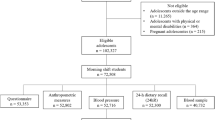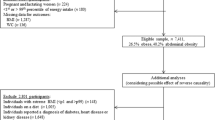Abstract
Background
Excessive energy intake and unbalanced food choices are major health concerns associated with obesity and related chronic diseases. This study evaluates the levels of dietary energy intake and the energy contributions of macronutrients, major food sources, and various eating occasions and processed food among Chinese adults.
Methods
The study examined a cross-sectional sample from CHNS and CNTCS 2015 that used three 24 h recalls and calculated energy intake and food sources based on the China Food Composition Table. After excluding extreme values, the analyses included 11,974 subjects aged 18–64.
Results
The estimated energy intake was 2063.3 kcal/d (2243.8 kcal/d for males and 1902.4 kcal/d for females), and 39.1% of subjects met the gender-age-PA-based Estimated Energy Requirement. The proportion of energy from fats was 35.8% without significant age or gender differences. Adults of lower socioeconomic statuses, indicated by lower education levels and lower household incomes per capita, consumed lower percentages of energy from fats and higher percentages from carbohydrates. The study population as a whole reported an average energy density of 1.88 kcal/g and an energy contribution from restaurant foods of 1.8%.
Conclusions
The study reports a lower energy intake level than CHNS 2009. Adults living in southern China or urban areas, which are relatively developed regions, or with higher socioeconomic statuses consumed less energy from carbohydrates, moderate amounts from proteins, and more from fats, indicating a need for dietary guidelines or interventions that take into account socio-demographic factors.
This is a preview of subscription content, access via your institution
Access options
Subscribe to this journal
Receive 12 print issues and online access
$259.00 per year
only $21.58 per issue
Buy this article
- Purchase on Springer Link
- Instant access to full article PDF
Prices may be subject to local taxes which are calculated during checkout
Similar content being viewed by others
Data availability
The datasets supporting the conclusions of this article are available in http://www.cpc.unc.edu/projects/china.
References
Zhang Y, Liu J, Yao J, Ji G, Qian L, Wang J, et al. Obesity: pathophysiology and intervention. Nutrients 2014;6:5153–83.
Donin AS, Nightingale CM, Owen CG, Rudnicka AR, Jebb SA, Ambrosini GL, et al. Dietary energy intake is associated with type 2 diabetes risk markers in children. Diabetes Care 2014;37:116–23.
Boden G, Homko C, Barrero CA, Stein TP, Chen X, Cheung P, et al. Excessive caloric intake acutely causes oxidative stress, GLUT4 carbonylation, and insulin resistance in healthy men. Sci Transl Med. 2015;7:304re7.
Almoosawi S, Prynne CJ, Hardy R, Stephen AM. Time-of-day of energy intake: association with hypertension and blood pressure 10 years later in the 1946 British Birth Cohort. J Hypertens. 2013;31:882–92.
Htun NC, Miyaki K, Song Y, Ikeda S, Shimbo T, Muramatsu M. Association of the catechol-O-methyl transferase gene Val158Met polymorphism with blood pressure and prevalence of hypertension: interaction with dietary energy intake. Am J Hypertens. 2011;24:1022–6.
Du SF, Wang HJ, Zhang B, Zhai FY, Popkin BM. China in the period of transition from scarcity and extensive undernutrition to emerging nutrition-related non-communicable diseases, 1949-1992. Obes Rev. 2014;15(Suppl 1):8–15.
Zhang B, Wang HJ, Du WW, Zhang JG, Su. C, Zhai FY.The trends of nutrients intake of Chinese residents in nine provinces from 1989 to 2009 (II) the energy intake trend of Chinese adults aged 18-49 years.Acta Nutrimenta Sinica. 2011;33:237–42.
Zhang J, Zhang B, Wang HJ, Du WW, Zhang JG, Zhai FY. [Trends in the energy intake among Chinese aged 50–79 years in nine provinces (1991–2009)]. Acta Nutrimenta Sin. 2011;33:335–9.
Yu DM, He YN, Guo QY, Fang HY, Xu XL, Fang YH, et al. [Trends of energy and nutrients intake among Chinese population in 2002–2012]. Wei Sheng Yan Jiu. 2016;45:527–33.
Duffey KJ, Popkin BM. Energy density, portion size, and eating occasions: contributions to increased energy intake in the United States, 1977–2006. PLoS Med. 2011;8:e1001050.
Du WW, Zhang B, Wang HJ, Wang ZH, Su C, Zhang JG, et al. Gender difference in the association between food away-from-home consumption and body weight outcomes among Chinese adults. Public Health Nutr. 2016;19:2984–90.
Naska A, Orfanos P, Trichopoulou A, May AM, Overvad K, Jakobsen MU, et al. Eating out, weight and weight gain. A cross-sectional and prospective analysis in the context of the EPIC-PANACEA study. Int J Obes (Lond). 2011;35:416–26.
Drewnowski A, Rehm CD. Consumption of added sugars among US children and adults by food purchase location and food source. Am J Clin Nutr. 2014;100:901–7.
Zhang B, Zhai FY, Du SF, Popkin BM. The China Health and Nutrition Survey, 1989-2011. Obes Rev. 2014;15(Suppl 1):2–7.
National Institute of Nutrition and Food Safety CC. China food composition. Beijing: Peking University Medical Press; 2009.
Society CN. Chinese Dietary Reference Intakes. Beijing: Beijing Science Press; 2014.
Zhang J, Wang D, Eldridge AL, Huang F, Ouyang Y, Wang H, et al. Urban-rural disparities in energy intake and contribution of fat and animal source foods in chinese children aged 4–17 years. Nutrients. 2017;9:526. https://doi.org/10.3390/nu9050526.
Zhang J, Wang Z, Wang H, Du W, Su C, Zhang J, et al. Association between dietary patterns and blood lipid profiles among Chinese women. Public Health Nutr. 2016;19:3361–8.
Zhang JG, Zhang B, Wang HJ, Wang ZH, Du WW, Su C, et al. [Dietary patterns of Chinese adults in nine provinces]. Zhonghua Liu Xing Bing Xue Za Zhi. 2013;34:37–40.
Song F, Cho MS. Geography of Food Consumption Patterns between South and North China. Foods (Basel, Switzerland). 2017;6:34. https://doi.org/10.3390/foods6050034.
Mayen AL, Marques-Vidal P, Paccaud F, Bovet P, Stringhini S. Socioeconomic determinants of dietary patterns in low- and middle-income countries: a systematic review. Am J Clin Nutr. 2014;100:1520–31.
Society CN. Chinese dietary guideline, 2016 Edition. Beijing: People’s Medical Publishing House; 2016.
Su C, Wang H, Wang Z, Zhang J, Du W, Zhang J, et al. [Status and trend of fat and cholesterol intake among Chinese middle and old aged residents in 9 provinces from 1991 to 2009]. Wei Sheng Yan Jiu. 2013;42:72–7.
Su C, Wang HJ, Wang ZH, Zhang JG, Du WW, Zhang J, et al. [Current status and trends of both dietary fat and cholesterol intake among Chinese children and adolescents aged 7 to 17 years old in 9 provinces of China, from 1991 to 2009]. Zhonghua Liu Xing Bing Xue Za Zhi. 2012;33:1208–12.
Pan K, Smith LP, Batis C, Popkin BM, Kenan WR,Jr. Increased energy intake and a shift towards high-fat, non-staple high-carbohydrate foods amongst China’s older adults, 1991–2009. J Aging Res Clin Pr. 2014;3:107–15.
Cui Z, Dibley MJ. Trends in dietary energy, fat, carbohydrate and protein intake in Chinese children and adolescents from 1991 to 2009. Br J Nutr. 2012;108:1292–9.
He L, Zhao WH, Zhang X, You Y, Chen JS. [Trend of seasonal change on intake of nutrients in a year of the residents in both northern and southern China]. Wei Sheng Yan Jiu. 2004;33:694–7.
Jones-Smith JC, Popkin BM. Understanding community context and adult health changes in China: development of an urbanicity scale. Soc Sci Med. 2010;71:1436–46.
Zhai FY, Du SF, Wang ZH, Zhang JG, Du WW, Popkin BM. Dynamics of the Chinese diet and the role of urbanicity, 1991-2011. Obes Rev. 2014;15(Suppl 1):16–26.
Konttinen H, Sarlio-Lahteenkorva S, Silventoinen K, Mannisto S, Haukkala A. Socio-economic disparities in the consumption of vegetables, fruit and energy-dense foods: the role of motive priorities. Public Health Nutr. 2013;16:873–82.
Grech AL, Rangan A, Allman-Farinelli M. Dietary energy density in the Australian adult population from national nutrition surveys 1995 to 2012. J Acad Nutr Diet. 2017;117:1887–99.e2.
Vernarelli AJ, Mitchell CD, Rolls JB, Hartman TJ. Dietary energy density is associated with obesity and other biomarkers of chronic disease in US adults. Eur J Nutr. 2015;54:59–65.
Zhou X, Xue H, Duan R, Liu Y, Zhang L, Harvey L, et al. The cross-sectional association of energy intake and dietary energy density with body composition of children in Southwest China. Nutrients 2015;7:5396–412.
Zhu Y, Hollis JH. Associations between eating frequency and energy intake, energy density, diet quality and body weight status in adults from the USA. Br J Nutr. 2016;115:2138–44.
Hingle MD, Wertheim BC, Neuhouser ML, Tinker LF, Howard BV, Johnson K. et al. Association between dietary energy density and incident type 2 diabetes in the women’s health initiative. J Acad Nutr Diet. 2017;117:778–85.
Tabesh M, Hosseinzadeh MJ, Tabesh M, Esmaillzadeh A. Effects of dietary energy density on serum adipocytokine levels in diabetic women. Horm Metab Res. 2013;45:834–9.
Drewnowski A, Specter SE. Poverty and obesity: the role of energy density and energy costs. Am J Clin Nutr. 2004;79:6–16.
Davis GC, Andrea C. The inverse relationship between food price and energy density: is it spurious? Public Health Nutr. 2014;18:1091–7.
Du WW, Su C, Wang HJ, Wang ZH, Zhang JG, Zhang J, et al. [Situation on ‘eating out’ and its related risk factors among 1013 Chinese adults in 3 provinces]. Zhonghua Liu Xing Bing Xue Za Zhi. 2013;34:1159–63.
Cao KK, He YN, Yang XG. [The association between eating out of home and overweight/obesity among Chinese adults]. Zhonghua yu fang yi xue za zhi. 2014;48:1088–92.
Bezerra IN, Sichieri R. Eating out of home and obesity: a Brazilian nationwide survey. Public Health Nutr. 2009;12:2037–43.
Lachat C, Nago E, Verstraeten R, Roberfroid D, Van Camp J, Kolsteren P. Eating out of home and its association with dietary intake: a systematic review of the evidence. Obes Rev. 2012;13:329–46.
Orfanos P, Naska A, Trichopoulou A, Grioni S, Boer JM, van Bakel MM, et al. Eating out of home: energy, macro- and micronutrient intakes in 10 European countries. The European Prospective Investigation into Cancer and Nutrition. Eur J Clin Nutr. 2009;63(Suppl 4):S239–62.
Guthrie JF, Lin BH, Frazao E. Role of food prepared away from home in the American diet, 1977–78 versus 1994–96: changes and consequences. J Nutr Educ Behav. 2002;34:140–50.
McGuffin LE, Wallace JM, McCrorie TA, Price RK, Pourshahidi LK, Livingstone MB. Family eating out-of-home: a review of nutrition and health policies. Proc Nutr Soc. 2013;72:126–39.
Archer E, Hand GA, Blair SN. Validity of U.S. nutritional surveillance:National Health and Nutrition Examination Survey caloric energy intake data, 1971–2010. PLoS ONE 2013;8:e76632.
Subar AF, Freedman LS, Tooze JA, Kirkpatrick SI, Boushey C, Neuhouser ML, et al. Addressing current criticism regarding the value of self-report dietary data. J Nutr. 2015;145:2639–45.
Freedman LS, Schatzkin A, Midthune D, Kipnis V. Dealing with dietary measurement error in nutritional cohort studies. J Natl Cancer Inst. 2011;103:1086–92.
Acknowledgements
This research uses data from the CHNS and the CNTCS. We appreciate the efforts of more than 1500 field investigators from 15 provinces and the support of all of the subjects.
Funding
The CNTCS received funding from Ministry of Finance of the People’s Republic of China (NO. 13103110700015005). The present study is also sponsored by Carolina Population Center (P2CHD050924, T32 HD007168), the University of North Carolina at Chapel Hill, the NIH (R01-HD30880, DK056350, R24 HD050924, and R01-HD38700) and the NIH Fogarty International Center (D43 TW009077, D43 TW007709) for financial support for the CHNS data collection and analysis files from 1989 to 2015 and future surveys.
Author information
Authors and Affiliations
Corresponding author
Ethics declarations
Conflict of interest
The authors declare no conflicts of interest.
Additional information
Publisher’s note Springer Nature remains neutral with regard to jurisdictional claims in published maps and institutional affiliations.
Supplementary information
Rights and permissions
About this article
Cite this article
Jiang, H., Zhang, J., Du, W. et al. Energy intake and energy contributions of macronutrients and major food sources among Chinese adults: CHNS 2015 and CNTCS 2015. Eur J Clin Nutr 75, 314–324 (2021). https://doi.org/10.1038/s41430-020-0698-0
Received:
Revised:
Accepted:
Published:
Issue Date:
DOI: https://doi.org/10.1038/s41430-020-0698-0



